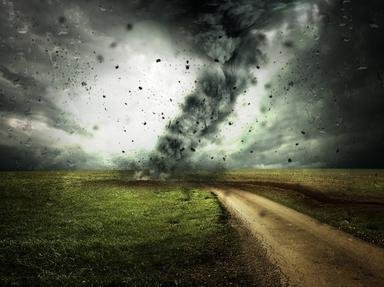Quiz Answer Key and Fun Facts
1. This storm began at 1:01 pm on March 18, 1925 in Southeast Missouri. It travelled at a speed of 62 mph with wind speeds of 261-318 mph. Areas affected were Missouri, Illinois, and Indiana. The death toll from this storm was 695+. What is this storm known as?
2. This storm was first tracked in Cuba on September 3, 1900 and struck land on September 4, 1900. The death toll from this storm is estimated and 6,000-12,000, making it the most deadly storm in US history.
3. A blizzard is a heavy snowstorm with extremely cold temperatures, sustained winds of at least 35 mph, and visibility of less than 0.25 mile. One of the worst blizzards ever in the US took place on January 27-28, 1922, and is called "The Knickerbocker Storm". Where did the name "The Knickerbocker Storm" come from?
4. On April 3-4 of one year during a sixteen hour period, one of the worst tornado outbreak in US history took place with 148 twisters touching down in thirteen states. What was the year?
5. The Great Atlantic Hurricane of 1944 came ashore near Cape Hatteras, NC on September 14. It moved north/northeast through New England and Canada. Although this hurricane is estimated to have killed 46 people and done $100 million in damage in the US, it caused its greatest harm somewhere else. Where was this?
6. In 1999 a tornado occurred that was too large and had wind speeds too high to fit the official statistics of the Fujita scale, which until 2007 was the official scale used to measure the size and wind speeds of a tornado. Where did this tornado take place?
7. Which of the following things did not cause the "Black Blizzards" of the 1930's?
8. Although not officially called a "storm", a heat wave can do just as much, if not more, damage. In one particular year, a heat wave in the US killed at least 1,700 people and did $15-19 billion in damage. What year was this?
9. Some of the worst storms in history have produced large hailstones that have added to the economic damage from the storm. The largest hailstone ever officially recorded in the USA was 8 inches across with a circumference of just over 18.6 inches. In what state did this hail stone fall?
10. Finally, the strongest hurricanes are rated Category 5. A hurricane seldom makes landfall at Category 5. In fact only three hurricanes in US recorded history have ever made landfall at Category 5. Which of the following hurricanes did NOT make landfall as a Category 5 hurricane?
Source: Author
chicochi3
This quiz was reviewed by FunTrivia editor
bloomsby before going online.
Any errors found in FunTrivia content are routinely corrected through our feedback system.

